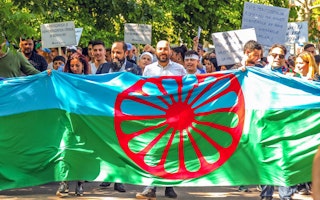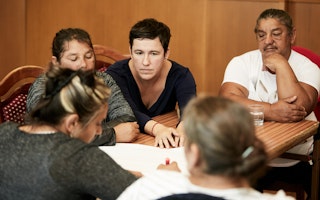Call the Witness: Rushdie on Roma
By Bernard Rorke
Salman Rushdie recently reflected on Italian prime minister Silvio Berlusconi’s comment that if Milan went to the left in the election, the city would be "flooded by Muslims and Gypsies":
The results show that the people of that city demonstrated better sense than their prime minister, and hopefully that is a sign of a change in the climate because certainly it is a horrifying thing that an entire ethnic group should be stigmatized in this country and in France and that a kind of ethnic cleansing should be carried out in Europe.
Rushdie’s testimony is one of the highlights of the Roma Pavilion, commissioned by the Open Society Foundations, at this year's Venice Biennale. His contribution is part of the Call the Witness project, which includes works of art, performances, and conversations with Roma and non-Roma artists, activists, public figures and intellectuals bearing witness to the struggles and challenges faced by Roma communities.
We live in the age of the migrant, said Rushdie, a time when more people have moved across the face of the world than ever before. The fact of migration has in large part defined modern urban life—"it is these movers who have shaken and shaped the world we live in"—an age when the majority of the inhabitants of the great cities of the world such as Bombay and New York were not born there. For a long time he has seen this as a creative force, remarking that "I myself would not be possible except in an age of migration," and that to create a hybrid world has always seemed to be an enriching thing.
But these days, he said, the subject of migration has become tinged with fear and unease. People have come to view migrant communities in their midst not as a source of enrichment, but rather to see them as other, alien and a source of sometimes fearful uncertainty: “Today there is a new fear-mongering politics which is creating a new xenophobia of the right.”
And the Roma are amongst the most vulnerable to this kind of xenophobia. Pricking the myths of rootedness and exclusivist notions of belonging that foster hostility towards the migrant other, Rushdie concluded his testimony with the following words:
To persecute groups like the Roma is to persecute our own secret selves. To criminalize an entire ethnic group is to vandalize our own secret identities …In our hearts we know that we are all misunderstood, how easy then to turn against the weakest in our midst and blame them for all our ills The Roma are in danger of becoming the scapegoats for our fears The real crime is ours, the crime of turning their life into a waking nightmare.
In another testimony, George Soros described the Roma Pavilion as more than an exhibition of works of art, but as an effort to bear witness to the poverty, alienation, and intimidation that Roma suffer today, and have suffered for centuries. Recounting the mass expulsions from France, the burning of camps and mob violence witnessed in Italy, and the killing spree of gun and bomb attacks targeting Roma settlements in Hungary which claimed nine lives, he declared that the Pavilion, "brings visitors face to face with disturbing facts and unpleasant realities. The goal is not to shock for the sake of shocking, nor to evoke sympathy, but rather to challenge us all to do something about an intolerable injustice."
This challenge is especially important in a time when neo-fascist militias and political parties are inciting hatred of Roma in Hungary and the Czech Republic, Soros said, and when political leaders disparage Roma as inferior human material, genetically disposed towards criminality, and describe Roma communities as "incubators of crime." Despite the racist hysteria, Soros asserted, there is a growing recognition, evidenced by the Decade of Roma Inclusion, that "the time has come for Roma to take their rightful place in a continent that considers itself civilized."
Soros described the many educated Roma he has encountered, increasingly confident in affirming their identity, visible in civic life, media, arts and academia, and shattering the prevailing stereotypes, as the "harbingers of a better future." Unfortunately they are a tiny minority of Europe’s 10-12 million Roma. He warned that while there is a clearly visible solution, the problem is actually getting larger, and concluded his testimony with the message: “We know what needs to be done, we just need to do it on a larger scale.”
Robert Kushen, director of the European Roma Rights Centre, in the opening remarks to his testimony said that it seemed presumptuous for him as a "nice Jewish boy from New Jersey" to bear witness on Roma, as his experience was by definition derivative. Taking advantage of this, he made his testimony derivative and gathered the quotes of others to shine a light on what shapes contemporary politics, and at the same time, give poetic voice to the desire for a very different world. The sources spanned centuries to include politicians and poets, racist rants from blog posts, anti-Roma graffiti, excerpts from old edicts of banishment to new provisions for mass deportations of Roma.
Kushen's testimony gave voice to Roma from all walks of life, to their aspirations, resilience, and pride in the face of hostility and humiliation. One highlight of the testimony was a quiz: "Who is the Nazi?" Interspersed, in chilling accord with, and virtually indistinguishable from utterances by 21st-century prime ministers and prominent politicians was a quote from Heinrich Himmler.
The Roma Pavilion was described in the Dutch daily NRC as sending "the most powerful signal to the others that the national pavilions in Giardini belong to the story of the past." It has also garnered praise in the other main Dutch daily newspaper, Volkskrant, for its clear artistic and political statement: "Here one could breathe in the air of openness and tolerance. A perfect connection to the general theme of the Biennale: Illuminations."
Until December 2013, Bernard Rorke was international research and advocacy director for the Roma Initiatives Office.


